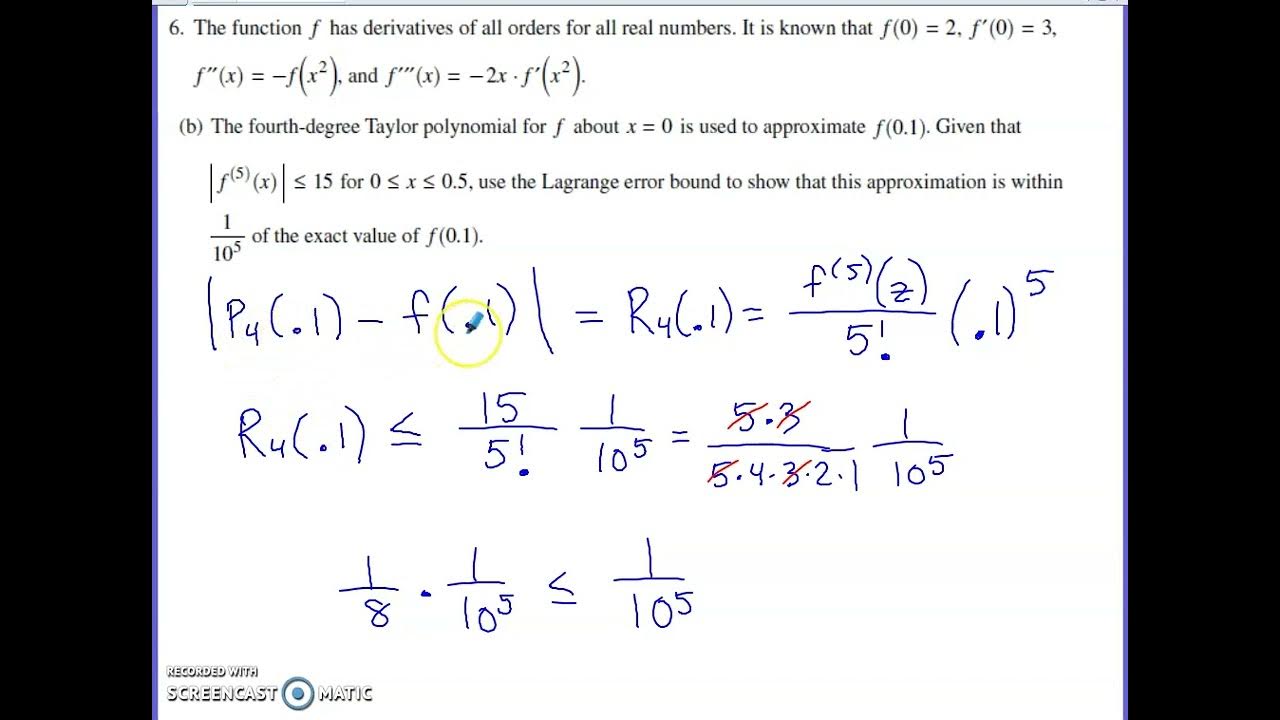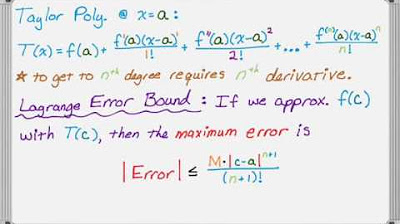2023 AP Calculus BC FRQ #6
TLDRThe video script discusses a problem from the 2023 AP Calculus BC Exam, focusing on a series problem involving a function f with derivatives of all orders. The task is to find the fourth derivative of f and write the fourth degree Taylor polynomial at x equals zero. The video provides a step-by-step approach to calculate the derivatives, starting with the given information about f(0), f'(0), and higher derivatives. It then uses the product rule to find the fourth derivative, which is shown to be -6 when evaluated at zero. The Taylor polynomial is constructed using the known derivatives, resulting in a simplified polynomial of 2 + 3x - x^2 - (1/4)x^4. Part B of the problem involves using the fourth degree polynomial to approximate f(0.1), with an error bound provided by the LaGrange error bound. The video demonstrates that the approximation error is within the specified tolerance. Finally, the script introduces a new function G and derives its second degree Taylor polynomial around x equals zero, using the given information about G and its derivative. The video concludes by simplifying the polynomial for G.
Takeaways
- 📚 The video discusses problem number six from the 2023 AP Calculus BC Exam, which is a series problem.
- 🔍 The function f has derivatives of all orders for all real numbers, with specific values given for f(0), f'(0), f''(x), and f'''(x).
- 🌟 Part A requires finding the fourth derivative of f and writing the fourth degree Taylor polynomial at x=0, showing all work.
- ✅ The fourth derivative of f at zero is found to be -6 by applying the product rule and evaluating at x=0.
- 📝 The fourth degree Taylor polynomial for f at x=0 is constructed using the known derivatives and is simplified to 2 + 3x - x^2 - (1/4)x^4.
- 🔢 Part B involves using the fourth degree polynomial to approximate f(0.1) and applying the LaGrange error bound with a maximum fifth derivative value of 15.
- 📉 The approximation error is shown to be less than 1/10^5 of the exact value, ensuring the approximation is within the specified tolerance.
- 🆕 A new function G is introduced in Part C, with g(0) given and g'(x) defined as e^x * f(x).
- 🔧 The second degree Taylor polynomial for G at x=0 is found by calculating G'(0) and G''(0), then applying the Taylor series formula.
- 📐 The polynomial for G simplifies to 4 + 2x + (5/2)x^2, which is derived from the given function and its derivatives.
- 💡 The video provides a comprehensive walkthrough of a series problem from the AP Calculus BC Exam, emphasizing the importance of understanding derivatives and Taylor polynomials.
- ⚙️ The process of finding higher-order derivatives, constructing Taylor polynomials, and applying error bounds is clearly explained, making the video a useful resource for exam preparation.
Q & A
What is the main topic of the video?
-The video focuses on solving problem number six from the 2023 AP Calculus BC Exam, which is a series problem.
What is the first step in finding the fourth derivative of the function f?
-The first step is to apply the product rule using the known third derivative, which involves differentiating the first part and multiplying by the second part, and vice versa.
What is the value of the fourth derivative of f at x equals zero?
-The fourth derivative of f at x equals zero is -6, which is found by evaluating the expression f'(0) * (-2), given that f'(0) is 3.
How is the fourth degree Taylor polynomial for f at x equals zero written?
-The fourth degree Taylor polynomial is written as f(x) ≈ 2 + 3x - x^2 - (1/4)x^4, where the coefficients are derived from the function's derivatives evaluated at x=0.
What is the purpose of using the LaGrange error bound in Part B of the problem?
-The LaGrange error bound is used to show that the approximation of f(0.1) using the fourth degree polynomial is within a certain error margin, given the maximum value of the fifth derivative on the interval [0, 0.1].
How is the error in the approximation of f(0.1) using the fourth degree polynomial calculated?
-The error is calculated using the formula for the LaGrange error bound, which involves the maximum value of the absolute fifth derivative (M), the interval length raised to the power of the degree of the polynomial plus one, and divided by the factorial of that degree.
What is the maximum value given for the absolute fifth derivative in the LaGrange error bound?
-The maximum value given for the absolute fifth derivative is 15.
What is the function G defined as in Part C of the problem?
-The function G is defined such that G(0) is 4 and G'(x) is e^x * f(x).
What is the value of G'(0) in the function G?
-The value of G'(0) is 2, which is calculated as e^0 * f(0), given that f(0) is 2.
How is the second derivative of G, denoted as G''(x), found?
-G''(x) is found using the product rule, which involves the first derivative of the second part plus the second derivative of the first part, evaluated at x=0.
What is the second degree Taylor polynomial for G at x equals zero?
-The second degree Taylor polynomial for G at x equals zero is G(x) ≈ 4 + 2x + (5/2)x^2, which is derived from the function's derivatives evaluated at x=0.
Outlines
📚 Calculus Series Problem Overview
This paragraph introduces a series problem from the 2023 AP Calculus BC Exam. The focus is on a function 'f' with derivatives of all orders for real numbers. Key known values of the function and its derivatives at x=0 are provided, including F(0)=2, F'(0)=3, F''(x)=-F(x^2), and F'''(x)=-2x*F'(x^2). The task involves finding the fourth derivative, writing the fourth degree Taylor polynomial for F at x=0, and using the LaGrange error bound to show the approximation error for a given interval.
🔍 Deriving the Fourth Derivative and Taylor Polynomial
The paragraph outlines the process of finding the fourth derivative of the function 'f' using the product rule and the known third derivative. It then proceeds to construct the fourth degree Taylor polynomial at x=0, incorporating the values of the function and its first three derivatives at that point. The polynomial is simplified to a more manageable form for further use.
🔢 LaGrange Error Bound Application
This section deals with Part B of the problem, which involves using the fourth degree Taylor polynomial to approximate the value of F at x=0.1. It employs the LaGrange error bound to demonstrate that the approximation is within a certain tolerance, given the constraint on the absolute value of the fifth derivative. The calculation involves finding the maximum value of the fifth derivative over the interval [0, 0.1] and using it to bound the error of the approximation.
🎓 Constructing the Taylor Polynomial for a Related Function G
The final paragraph introduces a new function 'G' with given values for G(0) and G'(x), and the task is to find the second degree Taylor polynomial for G about x=0. It involves calculating G'(0) and G''(0), then using these values to formulate the polynomial. The paragraph concludes with the simplified form of the Taylor polynomial for G.
Mindmap
Keywords
💡AP Calculus BC Exam
💡Derivatives
💡Taylor Polynomial
💡Product Rule
💡Chain Rule
💡Lagrange Error Bound
💡Function Evaluation
💡Factorial
💡Series
💡Function Approximation
💡e to the x
Highlights
The video discusses problem number six from the 2023 AP Calculus BC Exam, which is a series problem.
Function f has derivatives of all orders for all real numbers.
Given that F(0) is 2, F'(0) is 3, and F''(x) is negative f(x) squared.
The third derivative F''' is negative two x times F'(x) squared.
Part A requires finding the fourth derivative and writing the fourth degree Taylor polynomial for F at x=0.
The fourth derivative is found using the product rule and evaluated at zero to get -6.
The fourth degree Taylor polynomial for F at x=0 is approximated as 2 + 3x - x^2 - (1/4)x^4.
Part B involves approximating F(0.1) using the fourth degree polynomial and the LaGrange error bound.
The absolute value of the error is shown to be less than 1/10^5 of the exact value using the fifth derivative's maximum value of 15.
The LaGrange error bound is simplified to demonstrate the approximation's accuracy.
A new function G is introduced with g(0) = 4 and G'(x) = e^x * F(x).
The second degree Taylor polynomial for G about x=0 is derived using given values and product rule.
G'(0) is calculated to be 2, and G''(0) is found to be 5.
The second degree Taylor polynomial for G at x=0 is written as 4 + 2x + (5/2)x^2.
The video provides a comprehensive walkthrough of calculus problems, including the application of Taylor polynomials and error bounds.
The presenter emphasizes the importance of showing work and understanding the underlying calculus concepts.
The video concludes with a positive note, wishing viewers good luck in their calculus endeavors.
Transcripts
Browse More Related Video

2023 AP Calculus BC Free Response Question #6

2011 Calculus BC free response #6d | AP Calculus BC | Khan Academy

The Lagrange Error Bound for Taylor Polynomials

Worked example: Taylor polynomial of derivative function | AP Calculus BC | Khan Academy

2006 AP Calculus AB Free Response #6

Avon High School - AP Calculus BC - Topic 10.12 - Example 3
5.0 / 5 (0 votes)
Thanks for rating: